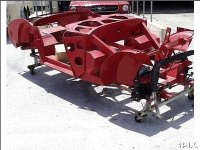We went out for a ride last week to meet up with Martin Jansen at Jule Enterprise to get his opinion on the frame of our 1960 BN7.
The diagnosis wasn't great. The door gaps at the top (back) were tight relative to everything else. As soon as we got the car on the lift the frame flexed and the doors sprung open. I'd say the door openings spread about 1/4" between the top of the door and the shut face. That wasn't the surprise. (Thoughts/fixes for this?)
The surprise came in the front end. We had noticed that the front tires were wearing unevenly. We prepared to do an alignment only to find that the camber of the right tire was way out (the real reason we went to talk with Martin). What we found. The chassis rails from the engine mounts forward had some waves in them. As well, the top of both sides of each frame rail had slight buldges in them in front of the engine mounts. Martin explained that this was a common stress point in the rails as a result of engine weight (I think that's how he explained it). The other thing that he noticed was that the lower pulley was closer to the crossmember than normal. Again, he felt that it was pretty common. The bottom of the crossmember has taken a hit as well.
He said if we replaced the crossmember as part of the camber correction, there's no guarantee that it'll take. In other words the frame could relax back into the exact same postion.
So all that being said, what do we do? Replace the front sections of chassis rails? (I've noted that Moss sells these.) Replace the front crossmember? I've also had someone suggest that we replace just the bottom half of the entire length of the chassis rails. Apparently this can be done with the car fully assembled. What would this accomplish? Frame flex at the doors? We are hoping to not get into a $50,000 resto, just to get the frame right because the rest of the car is in great shape. Are we going to have to disassemble the entire car to do the work that needs to be done? What do we do?
Whew! Thanks.
The diagnosis wasn't great. The door gaps at the top (back) were tight relative to everything else. As soon as we got the car on the lift the frame flexed and the doors sprung open. I'd say the door openings spread about 1/4" between the top of the door and the shut face. That wasn't the surprise. (Thoughts/fixes for this?)
The surprise came in the front end. We had noticed that the front tires were wearing unevenly. We prepared to do an alignment only to find that the camber of the right tire was way out (the real reason we went to talk with Martin). What we found. The chassis rails from the engine mounts forward had some waves in them. As well, the top of both sides of each frame rail had slight buldges in them in front of the engine mounts. Martin explained that this was a common stress point in the rails as a result of engine weight (I think that's how he explained it). The other thing that he noticed was that the lower pulley was closer to the crossmember than normal. Again, he felt that it was pretty common. The bottom of the crossmember has taken a hit as well.
He said if we replaced the crossmember as part of the camber correction, there's no guarantee that it'll take. In other words the frame could relax back into the exact same postion.
So all that being said, what do we do? Replace the front sections of chassis rails? (I've noted that Moss sells these.) Replace the front crossmember? I've also had someone suggest that we replace just the bottom half of the entire length of the chassis rails. Apparently this can be done with the car fully assembled. What would this accomplish? Frame flex at the doors? We are hoping to not get into a $50,000 resto, just to get the frame right because the rest of the car is in great shape. Are we going to have to disassemble the entire car to do the work that needs to be done? What do we do?
Whew! Thanks.

 Hi Guest!
Hi Guest!

 smilie in place of the real @
smilie in place of the real @
 Pretty Please - add it to our Events forum(s) and add to the calendar! >>
Pretty Please - add it to our Events forum(s) and add to the calendar! >> 

